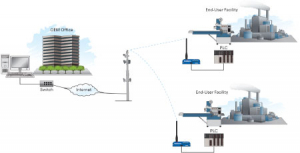Cellular provides cost-effective alternative to satellite, improving line integrity for a midstream oil company
Once named the oil capital of the world, Tulsa, Oklahoma rests near the foothills of the Southern Ozark Mountains.
Winding among these wooded hills and across the open wheatlands is a liquefied petroleum gas (LPG) pipeline belonging to a midstream oil company.
Nationwide, pipeline operational data is monitored in real time from the company's office control center in Texas. For security, safety, and real-time accessibility, all critical data is transmitted via satellite to the SCADA control center.
To improve line integrity, the engineering team responsible for this 100-mile LPG pipeline wanted to increase monitoring for some non-critical data points at 12 PLCs along the length of the pipeline. The crux: how to do so when their standardized satellite solution would be cost-prohibitive for these non-critical, low-data-transfer locations. Without additional monitoring points, they were left with visibility at only three points on the pipeline. In the event of a leak, discovery requires an operator to physically drive the entire length of the pipeline between point A and point B to locate the leak, which in this case could be anywhere along a 20-, 30- or 40-mile stretch of pipeline. From a line integrity standpoint, having nothing in between these points meant less resolution as to what was happening on the pipeline, and though leaks are rare, when they occur it’s essential to find and isolate them quickly for the safety of personnel, collateral, and the environment.
With the plethora of wireless products now available, the engineering team began investigating alternatives to satellite for these non-critical locations.
"When I was first approached about this opportunity, I immediately thought of ProSoft," said Brian White from Rexel. "With its extensive line of products and services and history of assistance to Rexel in Oklahoma, I felt confident they could provide a viable option for this application."
Originally, 900 MHz industrial radios were considered for these stations, because of their long-range capabilities and ability to penetrate foliage. Because of the dramatically different landscape, however, a site survey concluded that of these twelve locations, three lacked the required line-of-sight. To bring these sites onto the network, towers would have to be built, which would have brought the cost of implementation close to $100,000, rendering yet another solution infeasible.
Luckily, every site had cell service.
"Cellular technology is fantastic for real-time network access to industrial devices around the world," said the Wireless Product Marketing Manager at ProSoft Technology. "This application highlights the ease with which devices in remote areas can be made accessible at an affordable price."
Within three weeks from the time the order was placed, the radios were onsite. Installation was a challenge for the company only in that they had never worked with cellular. ProSoft Technology’s technician engineer walked them through the setup process, and with 15 minutes of setup per device, had the radios talking.
Results
The cellular radios are scattered along that length of the pipeline, monitoring line pressure and valve statuses along the way. Each radio is wired to a PLC via serial Modbus®, gathering information from their remote locations. A thirteenth cellular radio is connected to the satellite network, relaying data from all twelve points back to the control center in Texas.
By adding these data points to the network, the company was able to minimize risk while keeping the application safe and operational. In fact, using cellular has enabled them to pinpoint line pressures to 5-mile intervals versus 40, so should pressure drop off between two of these points, they can quickly isolate leaks with as little impact as possible.
For more information about ProSoft Technology’s Wireless Solutions, click here.



